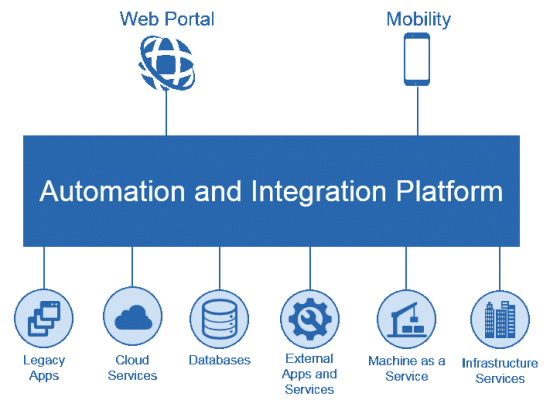The next big phase of the Internet is the race toward digitization, which brings together people, processes, data, and things in new, more productive ways. In this emerging hyper-distributed digital world, connectivity is even more vital than ever before. Companies that are going to thrive and realize new opportunities will be the ones that adopt digital strategies to bring new services to market faster, securely connect people, things, and stitch hyper-distributed processes across internal and external systems.
Cisco’s research shows that 75% of organizations need help in clearly defining the digitization opportunity that exists for each of them. This research is consistent with what I hear from customers across many industries that are challenged with integrating systems and processes rapidly for:
- Becoming agile as a business, adapting to changes with speed
- Engaging better with customers and leveraging partner ecosystems
- Improving productivity to improve revenues and profits
Expose, Compose, and Govern Any Asset
If every enterprise asset ranging from legacy applications, cloud services, data, partner services/apps, machines or things, to network/compute/storage infrastructure is viewed as a service, we need the following three capabilities to make those assets available within and across the enterprise:
All this sounds good on paper, but difficult to realize in practice. This requires organizations to think about their assets differently – both tangible assets such as people, machines, buildings etc. and intangible assets such as processes and data. All organizational assets need to be treated as services that are consumable by external or internal consumers; treated as services that are produced by various producers within the enterprise in a federated fashion.
- Expose assets as services – provide a catalog of assets exposed securely as apps, services, or APIs via marketplace catalogs and web or mobile portals
- Compose new services via mixing services – create new services, apps, and outcomes by connecting data, cloud, and enterprise systems
- Govern the services – develop policy-based access and control via API access control, fully federated single sign on and ID management.
These three capabilities will enable organizations to treat any asset as a programmable service that can be used by various consumers; to mix it with other services as needed to make new services, and to govern these services with the right authentication and authorization. This new approach to managing hyper-distributed assets provides your business with a framework that lets you automate and integrate your unconnected processes with complete security, governance, and visibility at every stage, allowing us to effectively collaborate with your customers and partners and improve operational efficiencies.
To help with this transformation, today I’m excited to introduce the Cisco Automation and Integration Platform that allows organizations to quickly Expose, Compose, and Govern (“E-C-G”) every enterprise asset as a service. The platform enables customers to act on insights through process automation within and outside of the enterprise, and across business and IT. It offers lifecycle management of digital assets across design, provisioning, publishing, and support. With the Cisco Automation and Integration Platform, our customers will be able to accelerate digital transformation initiatives by streamlining processes and simplifying collaboration amongst customers, partners, and internal stakeholders, as shown below.

Banking on Adaptive IT for Digitization
Organizations are putting pressure on IT to deliver solutions to business challenges that create value and leverage technology as a real differentiator for the organization. It’s a tall order under any circumstances, but especially in an age of rapid technology changes and high customer expectations. Existing solutions, as many organizations have discovered, are not up to the task.
For example: a large bank seeking to deliver on-demand IT services struggled with pressure from the business to deliver new services.
Like many enterprises, the bank was burdened with legacy IT architecture and manual processes that hindered service provisioning and resulted in average service fulfillment times of four to six weeks. To meet the business need to innovate and deliver new mobile and digital services, the IT organization needed to find a way to quickly use and reuse digital assets with speed and simplicity, while reducing process complexity and lowering delivery costs.
The bank leveraged the Cisco Automation and Integration Platform to automate organization, delivery, and consumption of information, creating an internal IT services marketplace portal that automated the workflow and delivery of development resources. The bank experienced rapid development, expanded offerings, and streamlined the procurement of IT services.
The bank cut their development time of new business applications from 180 days to 2 days, while reducing their costs by 30 percent. They transformed their IT delivery model to one of on-demand self-service for their employees and became a Fast IT organization.
The Mantra for Digitization: Expose…Compose…Govern
The Cisco Automation and Integration Platform helps you digitize your business processes. It gives you the business agility to re-imagine existing business processes and create new business processes that better serve your business needs. The platform automates interactions at scale and captures key data for operational intelligence and service utilization. Tying business interactions to trigger actions within the IT infrastructure paves the way for business SLAs to be provided by an intelligent infrastructure, such as adapting network bandwidth for business needs. At Cisco, we are well on our way to the next stage of the Internet – to enable industrial automation at scale.
In future blogs, several experts from Cisco and I will showcase examples of customers who have achieved digital transformation in many ways: through business process automation, supplier collaboration, IoT integration and network automation. Meanwhile, I’m interested to hear about your challenges and opportunities to achieve digital transformation through process automation. Let me know what you are experiencing in this race to digitization.
The most important thing is accept yourself. Good post. Find Your Balance. Thanks Hari
Nice Text and useful.
Thanks.
A very good pitch for CTOs.
Very good read. I wonder how you can obtain that service. Through Cisco directly or advance service team?
nice text and useful